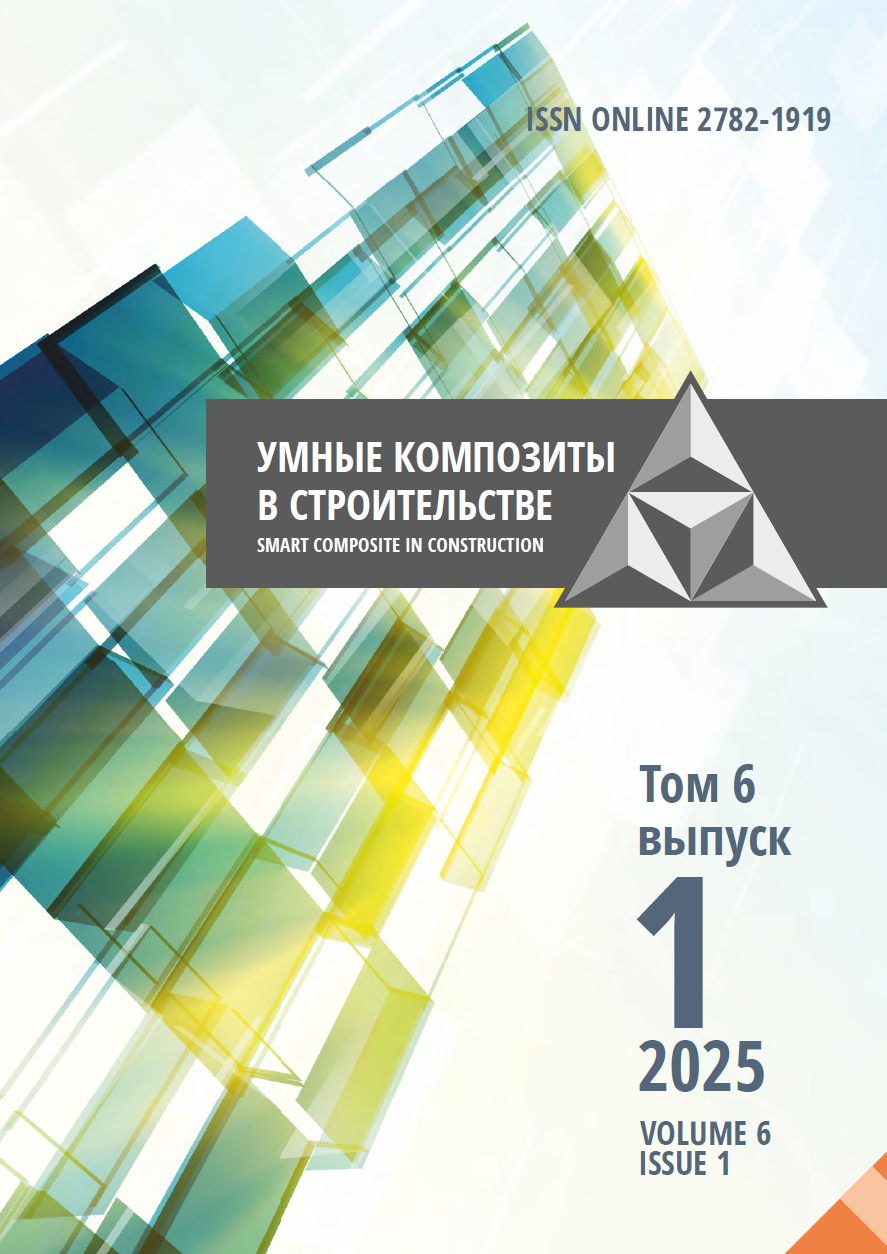employee
Nacional'nyy issledovatel'skiy Mordovskiy gosudarstvennyy universitet im. N.P. Ogareva (Department of Construction Structures, Professor)
employee
Saransk, Saransk, Russian Federation
Saransk, Saransk, Russian Federation
The authors have analysed the main advantages and disadvantages of construction polymer reinforcement. The authors used the experience of scientific research and industrial production of OOO ‘Cable Systems’ (Saransk, Russia). The paper provides general information about the types of composite reinforcement and the relevant regulatory documentation in the Russian Federation. The authors have performed a comparative analysis of the properties of composite polymer and steel reinforcement. The authors have revealed the impact of the composition of epoxy binder and reinforcing fibres on the most important consumer characteristics of composite reinforcement in general and, in particular, on the bond strength of composite reinforcement with concrete. The paper gives recommendations on the application of polymer composite reinforcement in solving complex problems in modern construction.
composite reinforcement, corrosion resistance, alkali resistance, concrete, polymer binder, sandy surface
1. Frolov, N.P. (1980), Stekloplastikovaya armatura i stekloplastbetonnye konstruktsii [Glass-fibre reinforcement and glass-fibre reinforced concrete structures], Stroyizdat, Moscow, 104 p. (in Russian).
2. Stepanova, V.F., Stepanov, A.Yu. and Zhirkov, E.P. (2013), Armatura kompozitnaya polimernaya [Composite polymer armature], Boumazhnik, Moscow, Russia, 200 p. (in Russian).
3. Klementiev, A.O. and Smerdov, M.N. (2013), "Literature review on the application of non-metallic composite reinforcement in reinforced concrete bridge spans", Vestnik Ural'skogo gosudarstvennogo universiteta putei soobshcheniya [Bulletin of Ural State University of Railway Engineering], vol. 4, no. 20, pp. 74-80 (in Russian).
4. Ovchinnikov, I.I., Ovchinnikov, I.G., Ilchenko, E.D. and Mikhaldykin, E.S. (2017), "Systematisation and analysis of normative and technical documentation on the use of polymer composite materials in transport construction", part 1, Internet journal ‘Naukovedenie’, vol. 9, no. 1, Available at: http://naukovedenie.ru/PDF/32TVN117.pdf (accessed 19.01.2025) (in Russian).
5. Keber, M.L., Vinogradov, V.M., Golovkin, G.S. et al. (2008), Polimernye kompozitsionnye materialy: struktura, svoistva, tekhnologiya: ucheb. posobie [Polymer composite materials: structure, properties, technology: textbook], in Berlin A.A. ed., Profession, SPb., Russia, 560 p. (in Russian).
6. Kochkova, Z.A., Zhavoronok, E.S. and Chalykh, A.E. (2006), Epoksidnye smoly i otverditeli: promyshlennye produkty [Epoxy resins and hardeners: industrial products], Paint-Media, Moscow, Russia, 200 p. (in Russian).
7. Tarnopolsky, Yu.M. and Kintsis, T.Ya. (1981), Metody staticheskikh ispytanij armirovannykh plastikov [Methods of static tests of reinforced plastics], Izd-wo ‘Khimiya’, Moscow, 271 p. (in Russian).
8. Khozin, V.G., Zykova, E.S., Fakhrutdinova, V.H. and Gizdatullin, A.R. (2015), "Effect of alkaline environment of concrete on epoxy binders and polymer composite reinforcement", Stroitel'nye materialy [Construction Materials], no. 1, pp. 41-44 (in Russian).
9. Starovoitova, I.A., Khozin, V.G., Suleymanov, A.M., Khalikova, R.A., Zykova, E.S., Abdulkhakova, A.A., Murtazina, A.I. and Khadeev, E.P. (2012), ‘Uniaxially oriented reinforced plastics: analysis of the state, problems and prospects of development’, Izv. KGASU [Proceedings of KGASU], vol. 4, no. 22, pp. 332-339 (in Russian).
10. Lobanov, D.S. (2015), Experimental investigations of deformation and strength properties of polymer composite materials and panels with filler: Ph.D. Thesis cand. tech. sc., Moscow, Russia, 148 p.
11. Rogatnev, Yu.F. and Javid, M.M. (2014), "Comparative analysis of experimental values of deformation and strength characteristics of reinforcement of classes A400, A500C and A600b", Stroitel'naya mekhanika i konstruktsii [Construction Mechanics and Structures], vol. 2, no. 9, pp. 92-99 (in Russian).
12. Gil, A.I., Badalova, E.N. and Lazovsky, E.D. (2015), Fiberglass and carbon fibre reinforcement in construction: advantages, disadvantages, prospects of application, Vestnik Polotskogo gosudarstvennogo universiteta [Bulletin of Polotsk State University], Ser. F, no. 16, pp. 48-53 (in Russian).
13. Belutsky, I.Y. and Sim, A.D. (2020), "Specificity of design, fabrication of structures stress-reinforced with low-modulus composite reinforcement", Vestnik Sibirskogo gosudarstvennogo universiteta putei soobshcheniya [Bulletin of Siberian State University of Railway Engineering], vol. 3, no. 54, pp. 38-45 (in Russian).
14. Becker, A.T. and Umansky, A.M. (2018), "Polymer binder of composite reinforcement. Types, characteristics and prospects of modification", Vestnik nauki i obrazovaniya [Bulletin of Science and Education], vol. 3, no. 39, pp. 22-27 (in Russian).
15. Bondarenko, V.M. and Suvorkin, D.G. (1987), Zhelezobetonnye i kamennye konstruktsii: uchebnik dlya vuzov [Reinforced concrete and stone structures: textbook for universities], Vysh. shkola, Moscow, 384 p. (in Russian).
16. Khozin, V.G. and Gizdatullin, A.R. (2017), "Compatibility of polymer-composite reinforcement with cement concrete in structures", Stroitel'nye materialy [Construction Materials], no. 11, pp. 30-38 (in Russian).
17. The official site METALSERVICE. Fluted armature. Available at: https://mc.ru/metalloprokat/armatura_riflenaya_a3/mark/a500s (accessed 09.01.2025) (in Russian).
18. The official site of MEGASTROY. (2025), Fibreglass reinforcements and bars. Available at: https://saransk.megastroy.com/catalog/armatura?field142[]=%D1%81%D1%82%D0%B5%D0%BA%D0%BB%D0%BE%D0%BF%D0%BB%D0%B0%D1%81%D1%82%D0%B8%D0%BA%D0%BE%D0%B2%D0%B0%D1%8F (accessed 09.01.2025) (in Russian).
19. The official site of Leman PRO (Leroy Merlin). (2025), Fibreglass reinforcement. Available at: https://saransk.lemanapro.ru/catalogue/armatura/stekloplastikovaya/ (accessed 09.01.2025) (in Russian).







